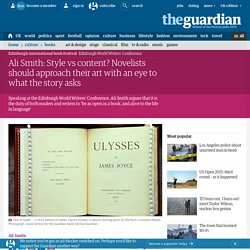

Ali Smith: Style vs content? Novelists should approach their art with an eye to what the story asks. Point 1: "What's it all about?

" v "What's it all – a bout? " Fight! Fight! Fight! In the style corner, a battered old copy of Ulysses. Or did he mean "Ulysses is a tweet"? Nothing is harmful to literature except censorship, and that almost never stops literature going where it wants to go either, because literature has a way of surpassing everything that blocks it and growing stronger for the exercise. Or maybe I'd read one of the most original writers at work in the novel in English right now, Nicola Barker.
I was thinking how incredibly precise those first lines were, and yet how crazily effortless they seemed; Schaefer's style (his – ahem – 'voice') so enviably understated, his artistic (if I may be so bold as to use this word, and so early in our acquaintance) 'vision' so totally (and I mean totally) unflinching.' Then he sums up the power the literary styles we love have over us: Let's just call it style. Point 2: style as more than one thing at once Point 3: style as content. The Art of the Sequel. The UK's Quarterly Almanac. Today's Most Popular Study Guides. The American Novel Since 1945 — Open Yale Courses.
Professor Amy Hungerford, Professor of English Description In "The American Novel Since 1945" students will study a wide range of works from 1945 to the present.

The course traces the formal and thematic developments of the novel in this period, focusing on the relationship between writers and readers, the conditions of publishing, innovations in the novel's form, fiction's engagement with history, and the changing place of literature in American culture. The reading list includes works by Richard Wright, Flannery O'Connor, Vladimir Nabokov, Jack Kerouac, J. Texts Richard Wright, Black Boy (American Hunger) (Harper Perennial Restored edition, 1993) 1945 Flannery O'Connor, Wise Blood (Farrar, Straus and Giroux) 1949 Vladimir Nabokov, Lolita (Vintage) 1955 Jack Kerouac, On the Road (Penguin) 1957 J.D. John Barth, Lost in the Funhouse (Anchor) 1963-68 (selections) Thomas Pynchon, The Crying of Lot 49 (HarperCollins) 1967 Toni Morrison, The Bluest Eye (Knopf) 1970 Edward P. Requirements 1. 2. Grading. Fiction's unsolved mysteries. A potential publisher, cordially refusing a novel synopsis of mine in the 1990s, told me: "Readers don't like unsolved mysteries.

They prefer things to be wrapped up. " I really don't agree. Mysteries always seem to want to be solved, it's true. And in literature's case, traditionally, they are – by the detective assembling those protagonists who have made it to the final chapter without being bumped off, and describing the machinations of the plot to them, before unmasking the perpetrator(s). We then find out whether we've guessed correctly ourselves, or whether we've been too gormless to note the sprinkling of clues. But what of the mysteries that remain unresolved? The mystery at the centre of A Passage to India (1924), meanwhile, may be unsolved for a different reason. And lack of resolution can go deeper than unsolved mysteries such as these. What has Josef K been accused of and by whom?
A mystery is a highly effective narrative device.